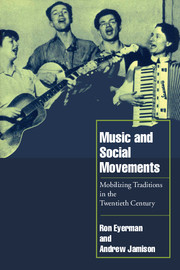Book contents
- Frontmatter
- Contents
- Acknowledgments
- Introduction
- 1 On social movements and culture
- 2 Taking traditions seriously
- 3 Making an alternative popular culture: from populism to the popular front
- 4 The movements of black music: from the New Negro to civil rights
- 5 Politics and music in the 1960s
- 6 From the sixties to the nineties: the case of Sweden
- 7 Structures of feeling and cognitive praxis
- Notes
- Bibliography
- Index
3 - Making an alternative popular culture: from populism to the popular front
Published online by Cambridge University Press: 26 October 2011
- Frontmatter
- Contents
- Acknowledgments
- Introduction
- 1 On social movements and culture
- 2 Taking traditions seriously
- 3 Making an alternative popular culture: from populism to the popular front
- 4 The movements of black music: from the New Negro to civil rights
- 5 Politics and music in the 1960s
- 6 From the sixties to the nineties: the case of Sweden
- 7 Structures of feeling and cognitive praxis
- Notes
- Bibliography
- Index
Summary
“The people is a myth, an abstraction.”
And what myth would you put in place of the people?
And what abstraction would you exchange for this one?
And when has creative man not toiled deep in myth?
And who fights for a bellyful only and where is any name worth remembering for anything else than the human abstraction woven through it with invisible thongs?
“Precisely who and what is the people?”
Is this far off from asking what is grass? what is salt? what is the sea? what is loam?
What are seeds? what is a crop? why must mammals have milk soon as born or they perish?
And how did that alfalfaland governor mean it: “The common people is a mule that will do anything you say except stay hitched”?
Carl Sandburg, The People, Yes (1936)Music and social movements in the United States
In contrast to the situation in most European countries, where cultural tastes and traditions have been dominated by the preferences of the bourgeoisie, American music, and cultural expression in general, has been strongly colored by the democratic values and the “exceptional” political and cultural experiences that have served to define the country's national identity. American culture has been essentially syncretic, whereby ways of life and forms of expression derived from different ethnic and national traditions have been combined into something new – what used to be called the “melting pot.”
- Type
- Chapter
- Information
- Music and Social MovementsMobilizing Traditions in the Twentieth Century, pp. 48 - 73Publisher: Cambridge University PressPrint publication year: 1998

